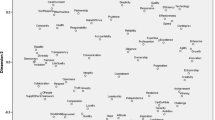Abstract
This research inductively identifies dimensions of organizational values which guide the operation and management of jails. A set of twenty-three value items were collected from jail administrators. Officers in five facilities were then asked to indicate the extent to which their administrators emphasized each value through their actions, statements, and policies. A principal components analysis showed that a subset of values could be represented by two underlying dimensions. A second survey of jail administrators showed that four values were consistently ranked as being of high priority relative to others. Implications for jail management are discussed and future research directions are offered.
Similar content being viewed by others
References
American Correctional Association (1990).National Jail and Adult Detention Directory. Lavral, MD: American Correctional Association.
Aquino, K. (1992). Guardians of the invisible cage: Developing and testing models of culture in U.S. jails. Unpublished Doctoral Dissertation, Northwestern University.
Berger, P.L. and T. Luckman (1966).The Social Construction of Reality: A Treatise on The Sociology of Knowledge. New York: Doubleday.
Beyer, J.M. (1981). ‘Ideologies, values, and decision making in organizations.’ In P.C. Nystrom and W.H. Starbuck (Eds.)Handbook of Organizational Design, Vol. 2, New York: Oxford University Press.
Block, J. (1977).The O-sort Methodology inPersonality Assessment and Psychiatric Research. Palo Alto, CA: Consulting Psychologist Press.
Bureau of Justice Statistics (1991).Correctional Population in the U.S., 1991. Washington, D.C.: U.S. Department of Justice.
Campbell, D.T. and D.W. Fiske (1959). ‘Convergent and discriminant validation by the multitrait-multimethod matrix.’Psychological Bulletin 56, 81–105.
Chatman, J.A. (1989). ‘Improving interactional research: A model of person-organization fit.’Academy of Management Review 14, 333–349.
Cooke, R.A. and J.C. Lafferty (1984,1986).Organizational Culture Inventory. Plymouth, MI: Human Synergistics.
Cooke, R.A. and D.M. Rousseau (1988). ‘Behavioral norms and expectations: A quantitative approach to the assessment of organizational culture.’Group and Organizational Studies 13, 245–273.
Enz, C.A. (1988). ‘The role of value congruity in intraorganizational power.’Administrative Science Quarterly 33, 284–304.
Flynn, E.E. (1983). ‘Jails.’ In S.H. Kadish (Ed.)Encyclopedia of Crime and Justice: Vol. 3 New York: Free Press, pp. 915–922.
Goldfarb, R. (1976).Jails: The Ultimate Ghetto of the Criminal Justice System. Garden City, NY: Anchor.
Gregory, K.L. (1983). ‘Native-view paradigms: Multiple cultures and culture conflicts in organizations.’Administrative Science Quarterly 28, 359–376.
Hambrick, D.C. and P.A. Mason (1984). ‘Upper echelons: The organization as a reflection of its top managers.’Academy of Management Review 9, 193–206.
Hofstede, G., B. Neuijen, D. Ohayv and G. Saunders (1990). ‘Measuring organizational cultures: A qualitative and quantitative study across twenty cases.’Administrative Science Quarterly 35, 286–316.
Houston, J.G., D.C. Gibbons and J.F. Jones (1988). ‘Physical environment and jail social climate.’Crime and Delinquency 34(4), 449–466.
Irwin, J. (1985).The Jail: Managing the Underclass in American Society. Berkeley: University of California Press.
Jackson, J. (1966). ‘A conceptual and measurement model for norms and roles.’Pacific Sociological Review 9, 35–47.
Katz, D. and R.L. Kahn (1966).The Social Psychology of Organizations. New York: Wiley.
Kerle, K.E. and F.R. Ford (1982).The State of Our Nation's Jails. Washington, D.C: National Sheriff's Association.
Kilmann, R.H. and M.J. Saxton (1983).The Kilmann-Saxton Culture Gap Survey. Pittsburgh, PA: Organizational Design Consultants.
Louis, M.R. (1980). ‘Surprise and sense making: What newcomers experience in entering unfamiliar organizational settings.’Administrative Science Quarterly 25, 226–251.
Mattick. H.W. (1974). ‘The contemporary jails of the United States: An unknown and neglected area of justice.’ In D. Glaser (Ed.)Handbook of Criminology. Chicago: Rand McNally.
O'Reilly, C. (1983). ‘Corporations, cults, and organizational culture: Lessons from Silicon Valley firms’. Paper presented at theAcademy of Management Meetings, Dallas, TX.
O'Reilly, C., J.A. Chatman and D. Caldwell (1991). ‘People and organizational culture: A profile comparison approach to assessing person-organization fit.’Academy of Management Journal 34(3), 487–516.
Peters, T. and R. Waterman (1982).In Search of Excellence: Lessons from America's Best-run Companies. New York: Harper and Row.
Pettigrew, A.M. (1979). ‘On studying organizational cultures.’Administrative Science Quarterly 24, 57–581.
Poole, E.D. and M.R. Pogrebin (1988). ‘Deputy sheriffs as jail guards: A study of correctional policy orientations and career phases.’Criminal Justice and Behavior 15(2), 190–208.
Poole, E.D. and M.R. Pogrebin (1991). ‘Changing jail organization and management: Toward improved employee utilization’. In J.A. Thompson and G.L. Mays (Eds.)American Jails 163–179. Chicago: Nelson-Hall.
Rokeach, M. (1968).Beliefs, Attitudes, and Values. San Francisco: Jossey-Bass.
Rousseau, D.M. (1990). ‘Quantitative assessment of organizational culture: The case for multiple measures.’ In B. Schneider (Ed.)Frontiers in Organizational Psychology: Vol. 3, pp. 153–192. San Francisco: Jossey-Bass.
Sashkin, M. (1984).Pillars of Excellence-The Organizational Beliefs Questionnaire. Bryn Mawr, PA: Organization Design and Development.
Saxton, M.J. (1987).The validation of the Kilmann-Saxton Culture-gap survey to testa theory of work group cultural norms and an exploration of a nomological network of culture. Unpublished doctoral dissertation, University of Pittsburgh, Pittsburgh, PA.
Schafer, N.E. (1986). ‘Jails and judicial review: Special problems for local facilities.’ In D.B. Kalinich and J. Klofas (Eds.),Sneaking Inmates Down the Alley: Problems and Prospects in Jail Management. Springfield, IL: Charles C. Thomas.
Schein, E.H. (1985).Organizational Culture and Leadership. San Francisco: Jossey-Bass.
Schein, E.H. (1990). ‘Organizational culture.’American Psychologist 45(2), 109–119.
Selznick, P. (1957).Leadership in Administration: A Sociological Interpretation. Evanston, IL: Row, Peterson.
Smircich, L. (1983). ‘Concepts of culture and organizational analysis.’Administrative Science Quarterly 28, 339–359.
Sykes, G. (1958).The Society of Captives: A Study of a Maximum Security Prison. Princeton, NJ: Princeton University Press.
Weick, K.E. (1979).The Social Psychology of Organizing. Reading, MA: Addison-Wesley.
Wilkins, A.L. and W.G. Ouchi (1983). ‘Efficient cultures: Exploring the relationship between culture and organizational performance.’Administrative Science Quarterly 28, 468–481.
Xicom, Inc. (1991).The Kilmann-Saxton Culture Gap Survey Instrument. Tuxedo, NY: Organizational Design Consultants.
Zupan, L.L., B.A., Menke and N.P. Lovrich (1986). ‘Podular/direct supervision detention facilities: Challenges for human resource development’.First Annual Symposium on Direct Supervision Jails. Washington, D.C.: National Institute of Corrections, 29–41.
Zupan, L.L. and B.A. Menke (1991). ‘The new generation jail: An overview.’ In J.A. Thompson and G.L Mays (Eds.)American Jails 180–194. Chicago: Nelson-Hall.
Author information
Authors and Affiliations
Rights and permissions
About this article
Cite this article
Aquino, K. An exploratory study of organizational values in jails. Int J Value-Based Manage 8, 99–115 (1995). https://doi.org/10.1007/BF00892455
Issue Date:
DOI: https://doi.org/10.1007/BF00892455




